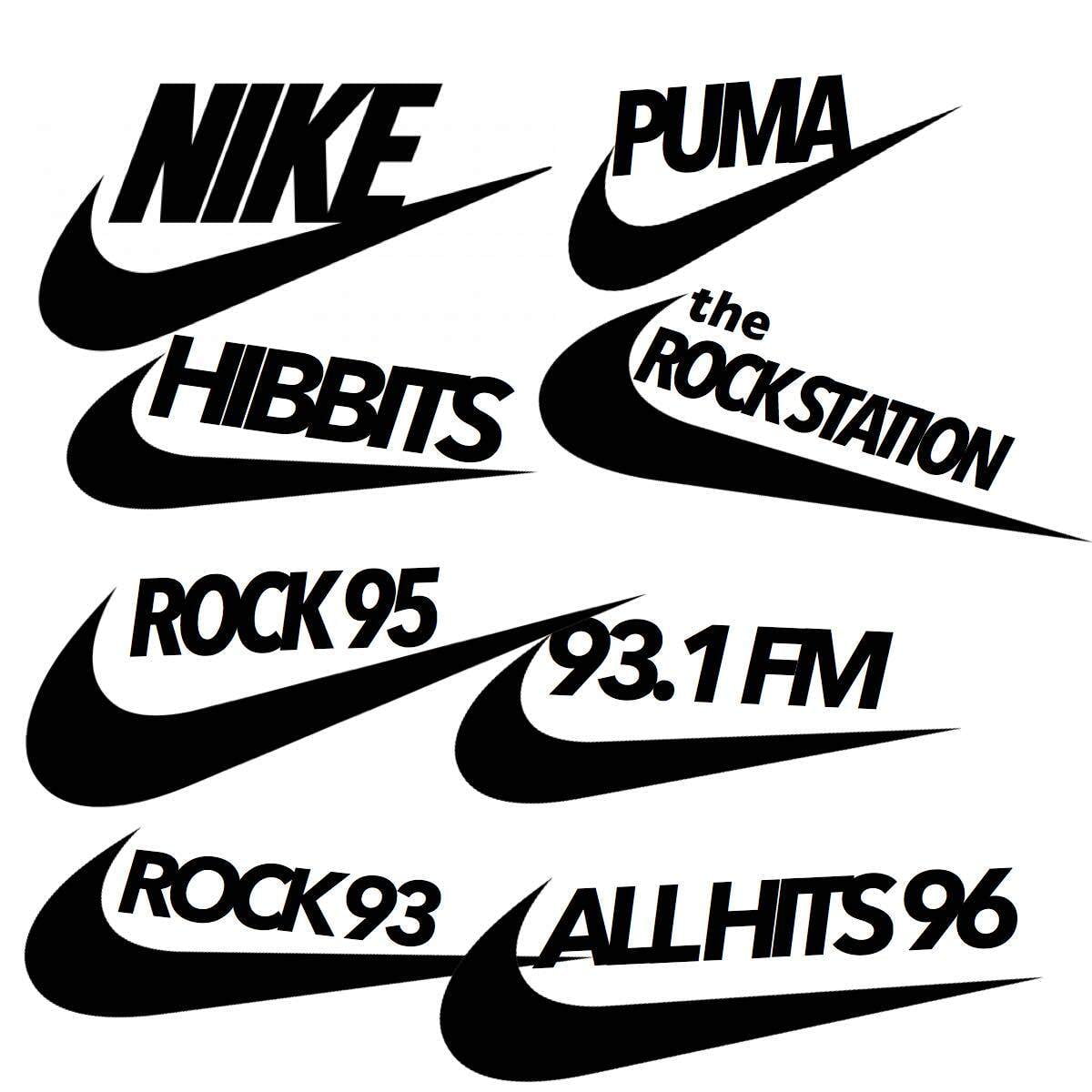"I’ve always felt that the over-abundance of deep voiced Rock Radio imaging in the 80s led to the more natural deliveries most stations have today. Remember when EVERY Rock station in America had Joe Kelly?"
- Jeff Murphy
DeMers ProgrammingTo understand why such thinking is anti-branding, look hard at the image below.

Right?
Sure, the Nike Crescent means sportswear. It's popular! So why not simply change only the text to your sportswear brand name, and keep the recognizable crescent?
Well, copyright laws aside...
Because branding, by definition, is totally about anti-sameness.
So, should your station use a "top" radio imaging voice? Before you answer, consider that people do surf the net for radio stations. Example: Our creative director here at the studio listens to 107.7 The End, in Seattle. And while we are 2000 miles from Seattle, The End uses the same imaging voice as does a rock station 50 miles away from our studio (which our office manager also sometimes dials in.) Given that our creative director is directly involved in branding, he asked me:
"Why on earth do so many radio stations share a branding element? They all sound the same!"
Using a top radio imaging voice; "the voice of rock", etc. and just having them read your station liners? In a radio world where groups of stations are redundantly programmed ad nauseam as per some "nation wide" template, your audience might have difficulty recognizing much difference between your station and others who use the same imaging voice and template.
Today's radio audience is sophisticated, engaged, and has a myriad of choices. The less your radio station sounds like the others, the better you'll be remembered and liked.
Popular vs unique radio imaging voices?
Ranking and choosing your radio station's next imaging voice based on"popularity" is the antithesis to branding. So let's take a deep dive into what branding is, and what branding should do.
I've said before: no one makes it to number one by sounding like someone else.
So what about landing at number 2?
Sure, that's pretty close. But being number 2 comes with nearly the same financial overhead as being number 1, but you don't get the same revenue intake as the number 1 station in your market. In fact, from a bottom line standpoint, if you're not ranking #1, it's probably better to aim for a much lower ranking than #2, because your overhead will be less--or at least be on par with your revenue. To understand how that works, check out a classic book on branding: Positioning: The Battle for Your Mind. You will get the full picture of the cost/benefit ratio of being #1 vs even a close #2.
The imaging voice: your brand spokesman
Here at Dogwood Productions, we deal with both broadcast imaging and advertising branding. From my perspective there should be zero difference in the approach to radio imaging vs product branding in advertising. So let me make a point using advertising branding as it relates to radio imaging and brand recall:
We all associate the GEICO Gecko lizard-man with insurance, and with GEICO. But wait–– are lizards a no-brainer when it comes to great spokesmen for insurance––or anything else for that matter? No? So what exactly makes that lizard a good spokesperson for GEICO??
Easy: he is totally unique. He's not cookie cutter. He's not the "voice of insurance". He is solely: The voice of GEICO.
But how might radio programmers approach a success like the GEICO Gecko. I'll wager a guess that competing radio stations all across America would all try and find the "best lizard" to be their spokesperson, because after all, they can point to the GEICO lizard and say: 'he's popular!" I bet many radio stations would just use that same lizard! I mean, he's all over America, right? Doesn't that make him the best for every insurance company?
No. The gecko means GEICO because... no other insurance company uses anything at all like a lizard!
In fact, some insurance branding doesn't even use any kind of animal at all––what a concept! Because they understand that to be recognized in the crowd, you need to stand out in the crowd.
So, next time you're searching for a new radio imaging voice, aim for a voice that doesn't sound at all like your competition--or maybe even (gasp) look for a voice that is totally NOT what the audience expects!
It's a simple concept, but I fear one that is missed by most radio programmers.
My top two imaging voice picks (off the top of my head right now)
I'm just riffing here, but if I could, I'd pick Bill Burr as my top radio imaging voice choice. Or how about Ron White for your country station? These two voices sound totally... um... different... right? Different from the stereotype radio imaging voice, and different from each other. Not only do their voice tones sound unique, but their pace and rhythm of speaking are totally unique. For sure, these guys are not just gonna be the "rip and read/you get what you get" voices so common to radio station imaging.
IMHO, the fact that the above 2 choices don't sound at all like radio imaging voices is exactly why they would be fantastic choices to create a totally unique radio station image.
Not saying these guys are available, but then again, I haven't asked-- and neither have you, right? Anyway, in a world where it seems everybody wants to be a voice actor, you should have no difficulty in finding a voice and style of delivery that will be both a fit for your station, and totally unique for your totally unique brand.

About Ray Norman
Ray Norman is a branding voice and sound designer, with over 3 decades producing broadcast imaging. You can hear examples here.